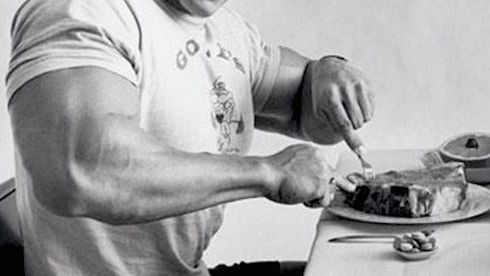

Words: Gentleman's Journal
Growing muscle is an expensive process, at least energy wise. Muscle tissue requires a lot of calories in order to grow and as such we need to provide our bodies with a good reason for why it should devote some of its resources to this cause. Well thought out resistance training acts as a good excuse for our body to build muscle, however this isn’t enough. Your nutrition will provide the physical resources needed to support this growth.
1. CALORIC REQUIREMENTS
First and foremost, our energy balance (calories in vs calories out) need to be in line with our goals. With hypertrophy being the goal, we need to be in a positive energy balance (calories in > calories out). Eating at maintenance is exactly what is says on the tin. It is eating the amount your body require to maintain homeostasis (its current state). With regards to muscle, homeostasis is when protein synthesis (think building) = protein degradation (think breakdown). Training disturbs this homeostasis and forces our bodies to dedicate extra energy towards managing the rebuilding of stronger muscle tissue to cope with new demand. Allowing for a caloric surplus (calories in > calories out) is vital in order to provide that extra energy.
Good place to start with regards to a Caloric Target is multiplying your weight in Kg by 31-35 depending on activity levels (more active = larger multiplier, vice-versa). Take that value and multiply by 15-25% depending on how rate of weight gain.
I.e. (75 Kg x 33) x 120%=2970 Kcal
Note: More aggressive rates of weight gain are more likely to occur alongside increase in body fat.
2. MACRONUTRIENT REQUIREMENTS (PROTEIN, FAT AND CARBOHYDRATE)
Protein is one of hell of an important nutrient when it comes to building muscle. Often, we find the majority of our clientele have trouble meeting protein requirements. Protein plays a huge role in providing the structural materials needed for hypertrophy to occur and, in turn, new muscle. Aiming to consume about 2g p/kg of bodyweight is a good place to start. If you wanted to take things that one step further, looking for proteins with a high leucine count is particularly advantageous as this amino acid acts as a trigger for increasing muscle anabolism (muscle building). Foods such as fish, chicken, beef, beans would be great sources.
Fat also has a role to play with regards to our goal of building muscle. An intake of about 20-30% of caloric intake have been shown to optimize the testosterone count, a hormone key to the muscle building process. Testosterone is an anabolic hormone, which means it facilitates the building of new tissues – in this case, muscle tissue.
So far we can calculate what our macronutrient requirements are…., Note: Protein/Carbohydrates = 4 Kcal, Fat = 9 Kcal
(75 x 33) x 120% = 2970 Kcal. Let’s round up to 3000 Kcal, 2g of protein p/ Kg of bodyweight = 150g of protein (600 Kcal), 25% of 3000 = 742.5 Kcal ÷ 9 = 83g of fat
Last but not least carbohydrates. The remaining calories can be dedicated towards carbohydrate intake which will fuel our training and support recovery. During resistance training, our main energy source derives mostly from stored muscle glycogen which we attain through carbohydrate intake. Hypertrophy requires relatively more volume and thus skewing ones intake towards carbohydrate would be advantageous. Upwards of 45% would be a good place to start.
More advanced trainee will require more volume load (Sets x Reps x Load) and perhaps utilise more advanced training methods. The extra workload will consequently require more fuel. In these cases aiming closer to 55% of your calories from carbohydrates would be wise.
This leaves us with a caloric goal of about 3000 Kcal. 150g of protein, 80-85g of fat and 400g of carbohydrates
3. MEAL FREQUENCY AND NUTRIENT TIMING
A common struggle amongst those trying to build muscle is actually getting the extra calories in. As discussed earlier this is paramount and therefore strategies should be look to facilitate a greater intake of calories. An easy way to immediately get one closer to their caloric targets is to simply add one meal to their existing eating routine. If this doesn’t yield results within 2-3 weeks, simply add another meal. For most people this takes us to 4-5 meals a day, which should suffice for the majority.
Nutrient timing is an area that has recently received a notorious amount of attention with efforts made to exploit the opportunity present during ‘the anabolic window’ and the recent paper by Nutritionist Alana Aragon published by in JISSN. So far the data seems to suggest that with regards to hypertrophy nutrient timing isn’t as important as we once thought. The total amount ingested within a 24-hour period is more important that the timing. The authors recommend that as long you ingest an ample serving of protein (20-30g) at some point within a couple of hours either side of the training bout.
By William McLintock and Tiago Ribeiro from the Matt Roberts City and Mayfair clubs


